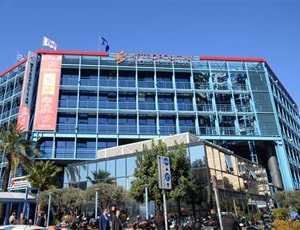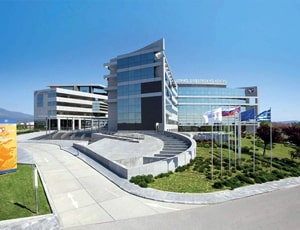The average cost of Craniotomy in Pireas approximately starts from USD 33000
Treatment cost

Apart from in-detail treatment procedures available, Metropolitan Hospital located in Pireas, Greece has a wide variety of facilities available for International Patients. Some of the facilities which are provided by them are Accommodation, Airport Transfer, Choice of Meals, Interpreter, SIM, TV inside room. Also listed below are some of the most prominent infrastructural details:


Apart from in-detail treatment procedures available, Medical Inter-Balkan Thessaloniki located in Thessaloniki, Greece has a wide variety of facilities available for International Patients. Some of the facilities which are provided by them are Accommodation, Airport Transfer, Choice of Meals, Interpreter, SIM, TV inside room. Also listed below are some of the most prominent infrastructural details:
Craniotomy surgery is one of the most common types of brain surgery conducted to treat a brain tumor. It mainly aims at removing a lesion, tumor, or a blood clot in the brain by opening a flap above the brain to access the targeted area. This flap is removed on a temporary basis and again put in place when the surgery is done. Around 90 percent of the cases of brain tumors are diagnosed in adults aged between 55 and 65. Among children, a brain tumor is diagnosed within an age range of 3 to 12 years.
Craniotomy procedures are conducted with the help of magnetic resonance imaging (MRI) scans to reach the location precisely in the brain that requires treatment. A three-dimensional image for the same is achieved of the brain in conjunction with localizing frames and computers to view a tumor properly. A clear distinction is made between abnormal or tumor tissue and normal healthy tissue and to access the exact location of the abnormal tissue.
In a minimally invasive craniotomy procedure, a burr hole or a keyhole may be created to access the brain to fulfill the following purposes:
When there are complex craniotomies involved, the procedure may be referred to as a skull base surgery. In this kind of surgery, a small portion of the skull is removed from the bottom of the brain. This is the region where delicate arteries, veins, and cranial nerves exit the skull. Complicated planning is done to plan such craniotomies and understand the location of the lesions. This type of approach is usually employed for:
Primary brain tumors are much less common than secondary brain tumors. Primary ones are found to originate very close to the brain itself or in the tissues very close to it, such as the covering membranes of the brain, including the meninges, cranial nerves, pineal, or pituitary gland. It begins with normal cells, which at a later period undergoes some mutational errors in their DNA. The mutation triggers cells to grow and divide at a very high rate while healthy cells keep dying around it. This results in a mass of abnormal cells which gives rise to a tumor. Unlike primary tumors, the secondary tumors begin as cancer elsewhere and spread to the brain.
No matter what the goal of the surgery is, it is best to ensure that the incision is made to address the intracranial lesion keeping some principles in mind. A wide variety of intracranial processes can be done via a craniotomy with a different variety of incisions. Some of these variations include frontal craniotomy, pterional craniotomy, temporal craniotomy, decompression craniectomy, and suboccipital craniotomy.
Ask your healthcare adviser for the best multiple options and choose the one that meets your expectations
In Pireas, the average starting cost for Craniotomy is $33000. There many OECI, TEMOS certified hospitals in Pireas that offer Craniotomy.
The cost of Craniotomy in Pireas may differ from one medical facility to the other. The top hospitals for Craniotomy in Pireas covers all the expenses related to the pre-surgery investigations of the candidate. The Craniotomy package in Pireas includes the fees of the surgeon, hospitalization and anesthesia as well. Stay outside the package duration, port-operative complications and diagnosis of a new condition may further increase the Craniotomy cost in Pireas.
There are many hospitals across the country that offer Craniotomy to international patients. The following are some of the most renowned hospitals for Craniotomy in Pireas:
While the speed of recovery may vary from patient to patient, they are still required to stay for about 23 days after discharge. This is important to ensure that the surgery was successful. During this time, control and follow-up tests take place to check for medical fitness.
One of the topmost destinations for Craniotomy is Pireas. It has a variety of accredited hospital, affordable cost of treatment and some of the best medical fraternity. However, there are other cities as mentioned below that are popular for Craniotomy as well:
There are certain additional cost that the patient has to pay apart from the Craniotomy cost. The per day extra expenses in Pireas per person are about 50 USD.
After the Craniotomy surgery takes place, the average duration of stay at the hospital is about 5 Days. The patient is subjected to several biochemistry and radiological scans to see that everything is okay and the recovery is on track. After making sure that patient is clinically stable, discharge is planned.
Out of all the hospitals in Pireas, there are about 1 Hospitals best hospitals for Craniotomy in Pireas. These hospitals have the required expertise as well as infrastructure available to handly patients who need Craniotomy. Apart from good services, the hospitals are known to follow all standard and legal guidelines as dictated by the local medical affairs body or organization.
Greece has a universal healthcare system that is supported by both government health insurance and private healthcare providers. There are a number of procedures provided at both public and commercial healthcare facilities in Piraeus. Additionally, the healthcare specialists working in the country follow the highest healthcare standards. The infrastructure of various medical institutions in the city is excellent and on par with most European countries. The city's hospitals provide high-quality care in areas like infertility, cardiology, neurology, nephrology, and other conditions. The city boasts a comparatively high concentration of specialist doctors who can manage any medical issue. Piraeus is home to several private health facilities, making it the best spot to go for treatment if you have private health insurance. The city’s hospital combines high-quality services with cutting-edge medical technology such as CT scans, MRIs, Cyberknife technologies, laser treatments, and so on.
The hospitals in Piraeus deliver quality care and treatment. They are internationally recognized and accredited by healthcare organizations like JCI and ISO. Some of the top hospitals in the city include:
The doctors in Piraeus play a vital role in delivering top-level health care services focusing on each patient’s needs. Some of the top doctors in the city include:
Piraeus is an easily reachable city by flight. The nearest airport to Piraeus is Athens International Airport. If you are planning to undergo treatment here, MediGence can assist you in planning your medical travel.